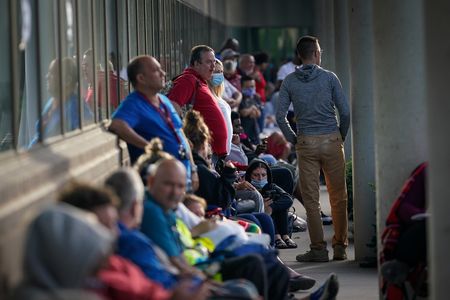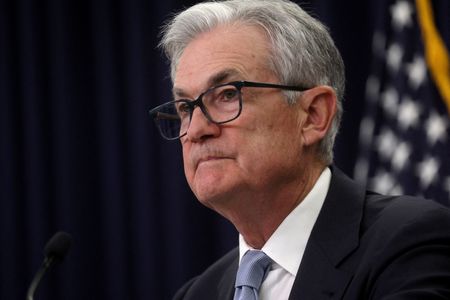By Howard Schneider
WASHINGTON (Reuters) – U.S. Federal Reserve officials, who hoped to return the job market to its 2019, best-in-a-generation status after the pandemic, may be on the verge of success as the economy passes key milestones for labor participation and nears a return to pre-pandemic trend levels of employment.
The question now: Will the victory be short-lived as those same policymakers battle inflation by engineering an economic slowdown aimed at undercutting conditions that have been tilted heavily in favor of workers?
At the onset of the pandemic, “getting back to where we were was the first reaction, and we are basically there” though with different patterns of employment and stronger wage growth, said Michael Madowitz, macroeconomic policy director at the Washington Center for Equitable Growth.
But while the Fed in 2019 was asking “‘is this as strong as the labor market can get?’ Right now inflation…is driving the policy discussion,” he said. Fed rate hikes could have “very significant, uneven short-term impacts” on the job market.
The Fed is expected to hold rates steady at its meeting this week but possibly flag further hikes later this year and project a rising unemployment rate.
So far headline payroll employment growth remains strong. U.S. employers added 339,000 positions in May, a pace well beyond what was normal before the pandemic. That left U.S. employment perhaps just a few hundred thousand jobs short of where it would have been had the pandemic not occurred.
But the number of unemployed and the unemployment rate both increased, the jobless rate for Black workers rose nearly a full percentage point, and wage growth slowed, potential signs that the conditions which fueled “the Great Resignation” and a spike in wages for lower-paid jobs may be turning.
WHAT CHANGED?
On many fronts the U.S. labor recovery from the pandemic remains a work in progress.
Within the service sector, key industries such as health and education are short workers, a fact attributed in part to pandemic-era changes in people’s preferences about work and the workplace. The leisure and hospitality industry remains about 350,000 jobs short of where it stood in February 2020, before the spread of COVID-19 forced the shutdown of many in-person services beginning that March.
But increasingly policymakers and economists talk about the impact of the pandemic not just as the sort of deep structural shock that it first seemed. There were initial concerns, for example, that women’s employment and labor-force participation would be permanently scarred by the pandemic, but recent estimates indicate it has fully recovered, or nearly so.
While there were clearly structural changes – like the explosion in at-home work – what has become increasingly clear is that the pandemic accelerated a reshuffling of workers across occupations and industries that was already underway: An economy in need of more managers and truck drivers during an e-commerce driven transportation boom, for example, became even more logistics driven. An aging society already needed more nurses and home health aides.
Recent data from the Bureau of Labor Statistics, for example, showed that a larger reshuffling of workers occurred in the three years from 2016 to 2019, when just over 5% of the workforce reallocated to a new occupation, than did so in the pandemic-influenced period from 2019 to 2022, when about 3.3% of the workforce crossed occupational lines.
It’s a process Fed officials see as not yet complete.
“I still feel like we’re deep into disequilibrium,” around the types of jobs that will be demanded and the working conditions agreed upon between businesses and employees, Atlanta Fed President Raphael Bostic said in a Reuters interview earlier this year.
In its most recent 10-year projections published last fall, the BLS said it anticipated annual employment growth, a broader notion than the monthly nonfarm payroll jobs number designed to capture things like self-employment, would slow in coming years to about half the 1% it averaged from 2011 through 2021. Of the additional 8.3 million jobs expected to be created in that period, nearly a third will be in health and social services, BLS projected.
WANTING IT BOTH WAYS
For now, though, the Fed might mark the pandemic labor rebound as essentially complete, despite the risks.
The unemployment rate has been under 4%, the Fed’s rough estimate of full employment, since January 2022.
The participation rate for 25-to-54 year olds, a measure of workforce engagement that sidesteps the issues of population aging, regained its pre-pandemic level of 83.1% in February and by May had risen to 83.4%.
The Center for American Progress and others have estimated that prime-age participation rates for women also reached a new high this spring. The numbers of foreign-born workers, according to the White House Council of Economic Advisers, has also recovered to trend after falling sharply during the Trump administration.
Overall payroll jobs, a headline figure decimated by the loss of 22 million jobs in the spring of 2020 and a benchmark of the recovery, may not be far behind.
Of course, it’s impossible to know what would have happened to U.S. employment absent the pandemic.
With a 3.6% unemployment rate at the end of 2019, the economy was considered close to full employment, but that doesn’t mean hiring would have gotten more difficult or that it would have remained healthy. Changes in labor supply might have allowed faster job creation; even without the health crisis other events might have caused the economy to slow and joblessness to rise.
The economy needs to create about 100,000 payroll jobs a month to keep pace with population growth. Had that occurred beginning in 2020 there would be about 156.4 million payroll jobs as of May – just 300,000 more than the current 156.1 million, statistically close and within a month or two of breakeven given the recent pace of job creation.
Whether labor market gains can last in the face of the central bank’s tightening campaign remains unclear, though Fed officials say they still hope to have it both ways: Cooling the economy enough to slow inflation without causing major damage to the job market their pandemic policies were meant to preserve.
(Reporting by Howard Schneider; Editing by Dan Burns and Andrea Ricci)






